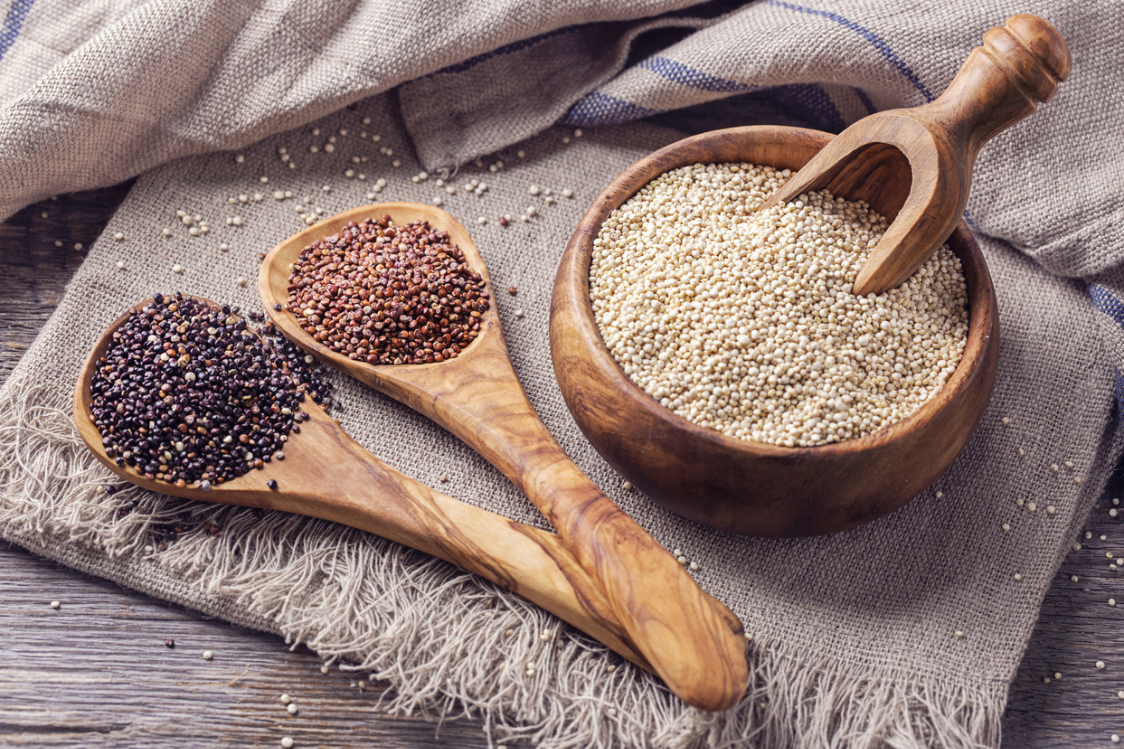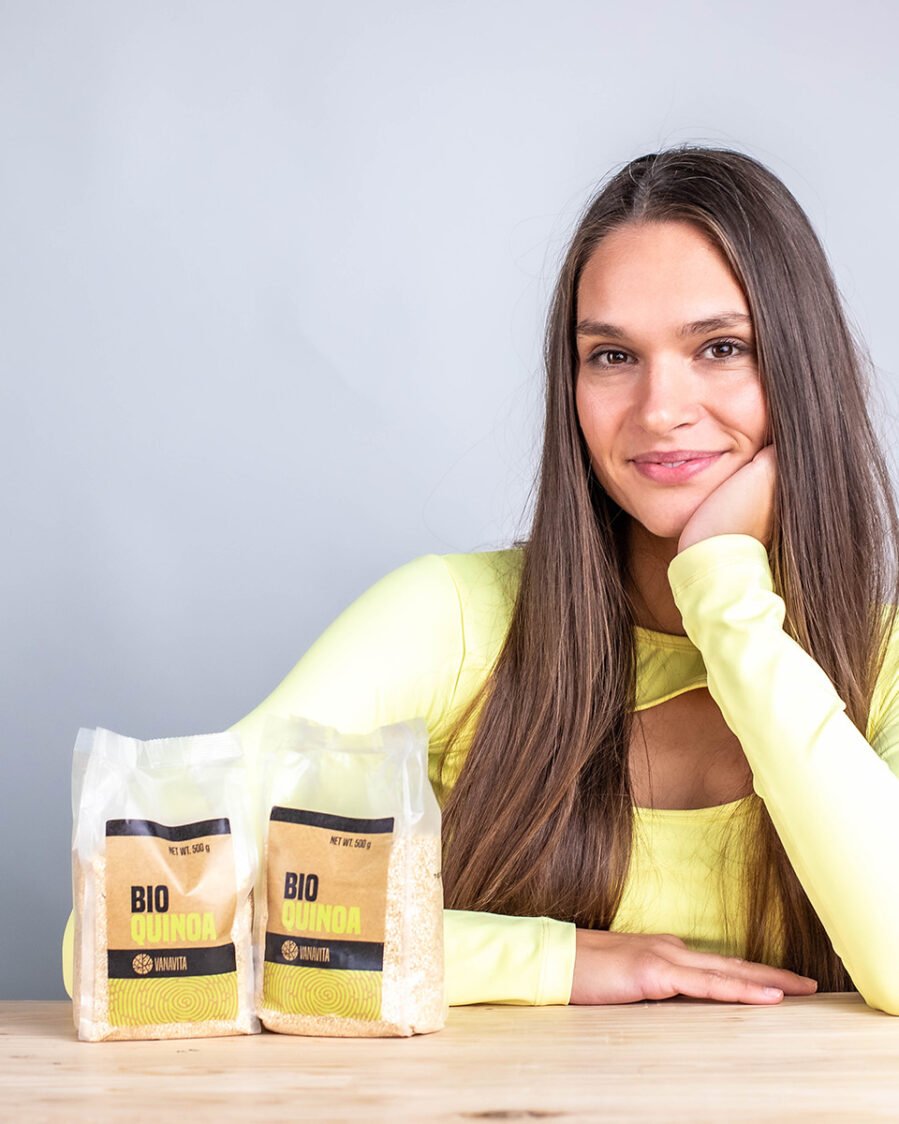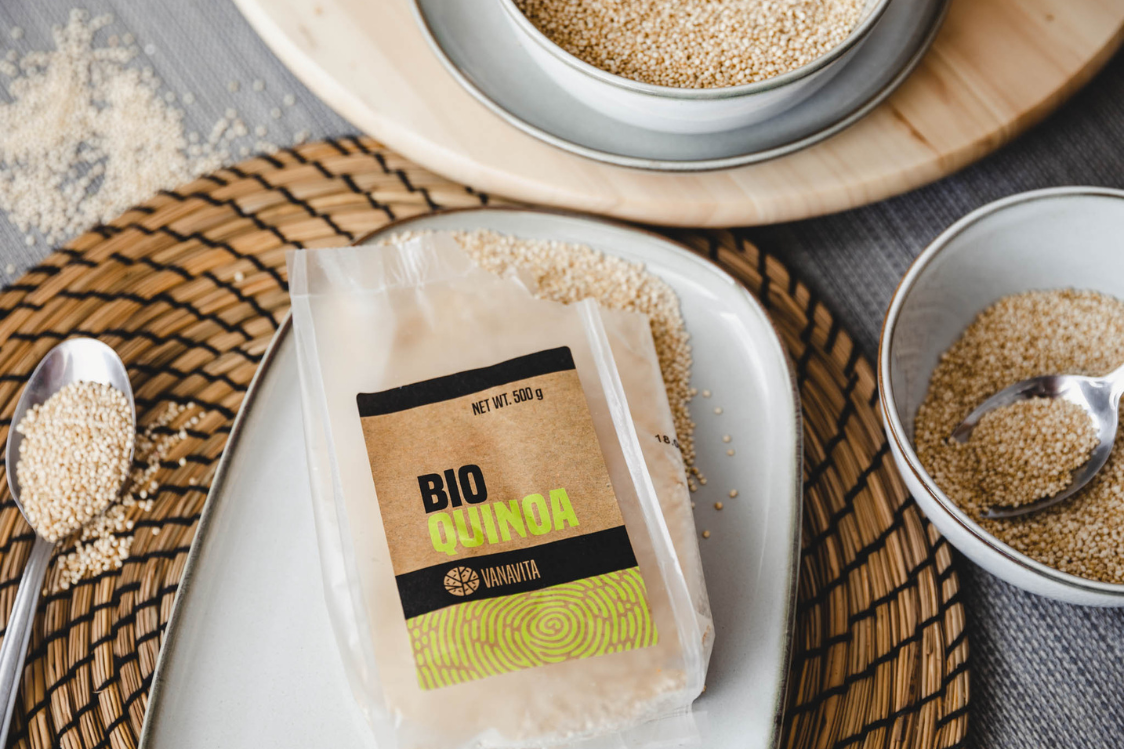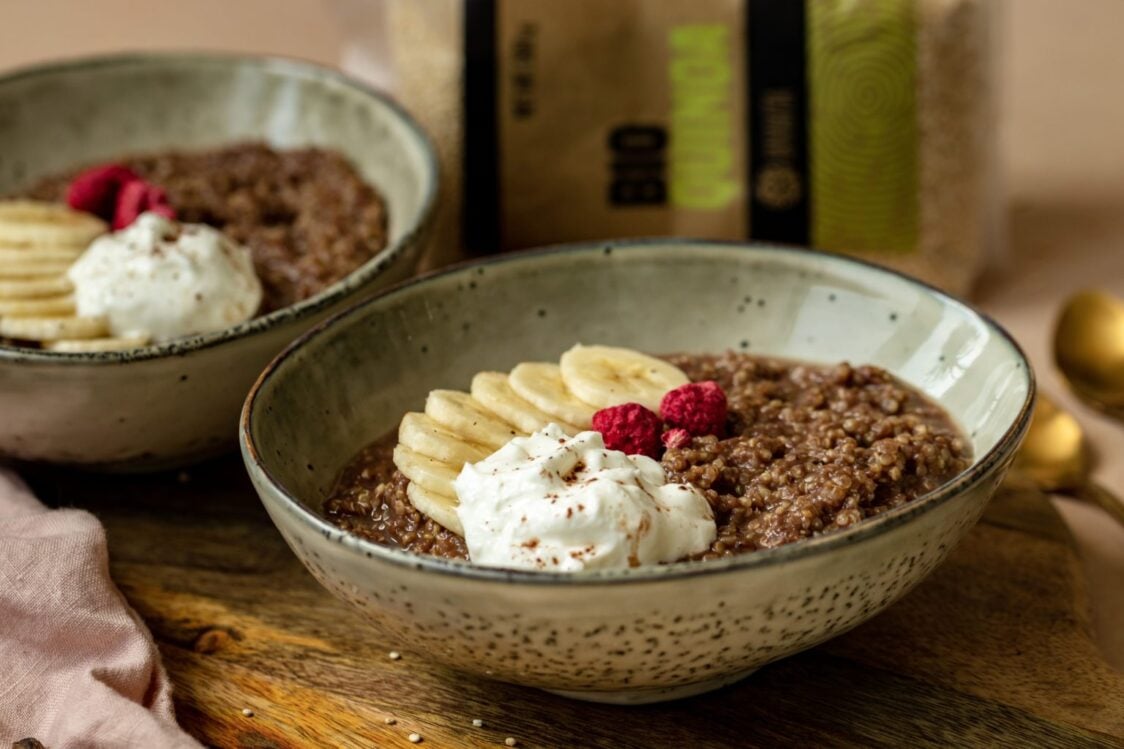Table of Contents
Do you only have a few common side dishes like potatoes, rice or pasta in your diet? Then you may be starting to feel like a healthy diet is pretty boring. But it’s definitely not. With today’s article, we decided to shatter this stereotype and take a closer look at another cool option, which is quinoa. This pseudo cereal has great nutritional values, tastes delicious, is simple to prepare, and can be eaten hundreds of ways. You definitely won’t get tired of it.
In this article you will read about the effects of quinoa on these areas:
In addition, you will also learn about these properties and benefits of quinoa:
What is quinoa, where does it come from and how does it taste?
Under the name quinoa you may know it as a plant called Chenopodium quinoa, which belongs among the pseudo-cereals. It differs from conventional cereals in that its small seeds, are not botanically classified as grains. However, their nutrient content and use in the kitchen are similar. It can therefore be used in the same way as, for example, rice. Quinoa is most commonly found in the form of side dishes, various mixtures with vegetables and meat or its vegetable alternatives (tofu, tempeh, seitan). However, it is also frequently added to various soups, salads, pancakes and other dishes.
It is thus a very versatile product. It is no surprise that it has a long tradition worldwide. Quinoa began to be cultivated in the South American Andes region several thousand years BC. The Incas even considered it a sacred food. But unlike potatoes or maize, it did not meet the same fate in Europe. In fact, quinoa was first labelled as un-Christian by the Spanish, which led to it ceasing to be grown in some areas. Over time, the production of quinoa together with other crops gave rise to the varieties that we still see today. Although there are more than 3000 varieties of quinoa, for simplicity’s sake it is most common to distinguish between white, red and black. Each has a slightly different nutritional profile, but all contain high levels of valuable micronutrients. This is also why it is considered a superfood. [23]
Whichever colour you choose, the quinoa will always have approximately the same shape in the form of tiny grains with a subtle nutty flavour that enhances sweet and savoury dishes. Like other pseudo cereals (buckwheat, amaranth), it has the advantage of being gluten-free. This will be appreciated by coeliacs and other people who avoid gluten for whatever reason. Moreover, study results show that quinoa production has been growing exponentially since 2013. The UN even declared that year the Year of Quinoa. In addition to its excellent nutritional profile, this is also because the plant can adapt to less favourable climatic conditions, which could help to ensure the supply of food to developing countries. Therefore, more people could benefit. Even NASA is interested in it as a potential food for astronauts. [1-3][25-23]

You might be interested in these products:
9 benefits of quinoa for health and a better shape
1. Gluten-free
Quinoa itself is a gluten-free food. This is supported by a study that investigated how a person with coeliac disease would respond to eating 50 g of quinoa a day for 6 weeks. Its consumption was well tolerated and did not impair health. This is good news for people who avoid gluten for whatever reason. But even though quinoa is naturally gluten-free, that doesn’t mean that other foods made from quinoa have to be gluten-free too. You always need to keep an eye on where the quinoa has been processed and whether other ingredients have been added during production that could cause digestive upset. [4]
Quinoa can therefore assist people on a gluten-free diet to replenish quality carbohydrates, protein and valuable micronutrients. At the same time, it will bring a fresh new taste to a gluten-free diet that is characterised by limited food choices.
2. A great source of plant protein
The great advantage of quinoa is the fact that it is one of the better quality sources of protein and not only for vegans. It is considered to be a complete protein, as it contains all the essential amino acids in an optimal ratio and can thus be said to have a high quality amino acid spectrum. Other plant protein sources, such as common cereals or legumes, typically have a limiting amino acid profile. Therefore, it is ideal to combine different sources with each other. However, this is not the case for quinoa. Unlike other cereals, it is also rich in lysine and other essential amino acids. This makes it a great addition to the diet of athletes who are interested in muscle growth, quality recovery or bone health. [5-6]

3. Can assist with weight loss
If you’re on a diet and trying to lose a few extra kilos of fat, quinoa can be a great food to serve on your plate regularly as part of your weight loss diet.
This is mainly due to the aforementioned high-quality protein and fibre content. These two ingredients help to keep you full for longer, which is ideal for weight loss.
This way they can help to reduce energy intake, maintain a calorie deficit and lose weight. In addition, protein-rich meals also help to keep cravings for sweet and salty treats at bay. This way, you leave the chocolate and other goodies in the pantry for someone else.
The protein in quinoa will also help with muscle maintenance and building, which will allow your body to burn more energy even at rest. This leads to a so-called acceleration of metabolism, which is also useful for weight loss. [7]
This goes hand in hand with the thermal effect of protein. It is the highest of all macronutrients (up to 30%). Simply put, this means that the body itself uses more energy to metabolise them, and to some extent, we burn calories for free. [7]
Of the 100 kcal ingested in the form of protein, our body uses up to 30 kcal just to process it. And you’ll be equally pleased to know that it has only an average of 6 g of fat per 100 g of raw quinoa [7]
Read our articles that will help make weight loss easier for everyone:
4. Has a positive effect on blood sugar levels
Due to its properties, quinoa can be considered a whole grain. Like whole grains, it is associated with a lower risk of type 2 diabetes and cardiovascular disease, distinguishing it from refined grains. In addition, it has a relatively low glycaemic index (average value of 53). This makes it an ideal choice for people who want to have better control over their blood sugar levels. When a product has a low glycaemic index, the sugar level rises gradually after eating it, it’s not like a roller coaster. This keeps us fuller longer and not hungry quickly after eating. All people who suffer from insulin resistance or type 2 diabetes can appreciate this. [8-12]
5. Positively affects cholesterol levels
High cholesterol levels increase the risk of developing heart disease, so it’s a good idea to keep an eye on it. If we take a closer look at the micronutrients in quinoa, we find that it contains an interesting amount of phytosterols. These are substances that have a similar structure to cholesterol. However, they have been shown to be able to reduce cholesterol absorption in humans. Thus, when consumed in large quantities, phytosterols can help to reduce the level of ‘bad’ LDL cholesterol in the blood.
This is also aided by the fibre contained in it. This binds bile acids in the digestive system and carries them out of the body. These molecules also have cholesterol integrated into them, which the body can then effectively get rid of. In addition, studies have shown that quinoa has been able to reduce blood triglycerides and free fatty acids. In this respect too, quinoa seems to excel in its category. [8-15]
6. Helps fight oxidative stress
Quinoa contains a number of other beneficial substances, including saponins, betalains, polyphenols, flavonoids and other important antioxidant substances. As a result, it helps fight oxidative stress and free radicals. And what does this mean in reality? Free radicals have the ability to damage cells in the body, which can lead to ageing. Oxidative stress in your bodies in turn increases the risk of a number of diseases. Antioxidants can thus help you take care of both your appearance and your health. [16]
7. It is beneficial for digestion
In this respect, the positive effect of quinoa is mainly due to its high fibre content, which is important for the proper functioning of your digestion. On average, you should eat around 30 grams of fibre per day, which quinoa, with its 7 grams of fibre per 100 grams, can effectively help with. It also serves as a food (prebiotic) for the bacteria living in your digestive tract. With the help of fibre, your microbiome will thank you and your digestion will run like clockwork. [17]
8. Easy preparation and use
The great advantage of quinoa is its ease of preparation. There is no peeling or cleaning required, such as with potatoes. Just rinse it thoroughly, mix it in the right proportion with water and boil it to the optimal consistency (usually about 15 minutes). When you’re done, all you have to do is decide how to use it. You can choose both sweet and savoury dishes. And it can be eaten as part of both hot and cold courses.

9. It has a low FODMAP content
Quinoa is also great for people following a low FODMAP diet. During this diet, try to reduce your intake of fermented oligosaccharides, disaccharides, monosaccharides and polyols. All these carbohydrates increase the osmolality of the intestine, to which the body responds by increasing the amount of water in the intestines. Metabolising foods high in FODMAPs can then lead to bloating, flatulence and other digestive problems. Quinoa, however, is one food that should not cause difficulties when following this diet. [18-19]
Discover our bestsellers:
What nutritional values does quinoa have?
Nutritional values are approximate and vary slightly between types. They depend on the quality of the soil, different cultivation and processing practices, and the type of quinoa. However, as you can see in the table, the differences between the average macronutrient values are not significant. Different types differ slightly in taste, but mainly visually. If you want your food to be more interesting to the eye, we recommend combining several types. The dish then plays with all the colours and is more appealing to the eye. [20]
|
White quinoa |
Red quinoa |
Black quinoa |
|
|---|---|---|---|
| Energy value | 356 kcal | 352 kcal | 355 kcal |
| Carbohydrates | 58g | 57 g | 59 g |
| Protein | 14 g | 14 g | 15 g |
| Fats | 6 g | 6 g | 5 g |
| Fibre | 7 g | 7 g | 7 g |
What vitamins and minerals does quinoa contain?
In addition to a balanced proportion of macronutrients, quinoa also boasts a good proportion of micronutrients, which include vitamins and minerals. [21]
Minerals in quinoa
- Iron is essential for red blood cell production, immunity, and helps reduce fatigue and exhaustion.
- Magnesium is important for mental function, the nervous system and proper muscle function.
- Phosphorus promotes normal teeth and bones.
- Potassium, like magnesium, contributes to the proper function of the nervous system, muscles and the maintenance of normal blood pressure.
- Zinc is important for cognitive function, normal testosterone levels in the blood, and also contributes to fertility.
- Copper is important for hair pigmentation, energy metabolism and the nervous system.
- Manganese helps with the maintenance of normal bones and tissues.
- Selenium is essential for spermatogenesis, hair, nails and thyroid function.
Vitamins in quinoa
- Thiamine (vitamin B1) is important for the heart, psyche, nervous system and energy metabolism.
- Riboflavin (vitamin B2) helps with normal energy metabolism, maintaining optimal skin condition, eyesight, and also helps to protect cells from oxidative stress.
- Pyridoxine (vitamin B6) supports the nervous system, the psyche, immunity and the production of red blood cells.
- Folic acid (vitamin B9, folate) is important, for example, for pregnant women as it contributes to the growth of germ tissues during pregnancy.
What is the antinutrient content of quinoa?
In addition to beneficial vitamins and minerals, quinoa also contains so-called antinutrients. In this category we include, for example, phytates and oxalates, which in large quantities, in combination with an inappropriate diet, could contribute to the formation of kidney stones in sensitive individuals. The saponin content of quinoa is similarly undesirable. These components can be partially removed by rinsing under running water. However, it is more effective to soak the quinoa in water for several hours, even overnight, before rinsing it. This method will help us to reduce the antinutrient content to a minimum.
However, there is no need to worry about antinutrients. For example, legumes and other cereals commonly contain them and they do not pose any significant problem for the general population. However, the issue of antinutrients will resonate with, for example, vegans, whose diet consists only of plant foods, and so a higher proportion of these ingredients can be expected. However, it will also be of interest to other people who need their diets to be spot on and perfected to the last detail.

How to prepare quinoa?
- The first and most important step is to rinse the quinoa thoroughly. This gets rid of impurities and saponins that give it a slightly bitter taste. It is ideal to rinse the quinoa under running water for at least 30 seconds. If you have time, it is fine to let it soak in water for up to 6 hours to get rid of more of the antinutrients before rinsing it.
- Then mix it with the amount of water indicated on the packet, as a rule, it is mixed with boiling water in a ratio of 1:2 (one part quinoa and 2 parts water).
- It is then simmered for about 14-18 minutes to give it the consistency that you like. Some people prefer harder, others softer. It also depends on how you want to use it afterwards.
- When it has the optimal consistency, you can turn off the stove and you’re done. [22]
Great recipes containing quinoa
As we have already mentioned, quinoa is a truly versatile product that can be eaten sweet, salty, cold or warm. So we’ve put together a few recipes that may inspire you to incorporate quinoa into your diet more often. The great advantage of already cooked quinoa is that it can last 5-7 days in the fridge if stored properly. You can have it ready and use it whenever you need it. You can also freeze it and then incorporate it into your meals whenever you want. [24]
Savoury recipes with quinoa
Sweet recipes with quinoa

What should you remember?
As you can see, quinoa is the ultimate versatile food with a multitude of benefits for your health. It is rich in protein, which is appreciated not only by those in the process of gaining muscle, but also in your diet. The high fibre content will be especially appreciated by your digestive system, for which this food component is crucial. And, of course, the content of vitamins, minerals, antioxidants and other beneficial ingredients must not be missed. If you want to boost your health, and also enjoy delicious sweet and savoury foods, then quinoa is a must-have in your pantry.
Do you know anyone in your circle of friends who hasn’t tried quinoa yet? Share this article with them so they too can discover the magic of this superfood.
[1] Safiullah Pathan,Rafat A Siddiqui – Nutritional Composition and Bioactive Components in Quinoa ( Chenopodium quinoa Willd.) Greens: A Review – https://pubmed.ncbi.nlm.nih.gov/35276913/
[2] Antonio Vega-Gálvez et al. – Nutrition facts and functional potential of quinoa (Chenopodium quinoa willd.), an ancient Andean grain: a review – https://pubmed.ncbi.nlm.nih.gov/20814881/
[3] Viktória Angeli et al. – Quinoa ( Chenopodium quinoa Willd.): An Overview of the Potentials of the “Golden Grain” and Socio-Economic and Environmental Aspects of Its Cultivation and Marketization – https://pubmed.ncbi.nlm.nih.gov/32092899/
[4] Zevallos, Victor F PhD et al. – Gastrointestinal Effects of Eating Quinoa (Chenopodium quinoaWilld.) in Celiac Patients – https://journals.lww.com/ajg/abstract/2014/02000/gastrointestinal_effects_of_eating_quinoa.21.aspx
[5] Lilian E Abugoch et al. – Study of some physicochemical and functional properties of quinoa (chenopodium quinoa willd) protein isolates – https://pubmed.ncbi.nlm.nih.gov/18489119/
[6] Limiting amino acids – https://www.asi.k-state.edu/extension/swine/swinenutritionguide/general_nutrition_principles/limitingaminoacids.html
[7] Duyff, R.L. Complete Food & Nutrition Guide. – New York: Academy of Nutrition and Dietetics, 2017. ISBN 978-0-544-52058-5.
[8] Glycemic Index Research and GI News – https://glycemicindex.com/gi-search/?food_name=quinoa&product_category=&country=&gi=&gi_filter=&serving_size_(g)=&serving_size_(g)_filter=&carbs_per_serve_(g)=&carbs_per_serve_(g)_filter=&gl=&gl_filter=
[9] Cristiana Berti et al. – In vitro starch digestibility and in vivo glucose response of gluten-free foods and their gluten counterparts – https://pubmed.ncbi.nlm.nih.gov/15309439/
[10] Anjali A Dixit et al. – Incorporation of whole, ancient grains into a modern Asian Indian diet to reduce the burden of chronic disease – https://pubmed.ncbi.nlm.nih.gov/21790614/
[11] Qi Sun et al. – White rice, brown rice, and risk of type 2 diabetes in US men and women – https://pubmed.ncbi.nlm.nih.gov/20548009/
[12] Kevin C Maki et al. – Dietary substitutions for refined carbohydrate that show promise for reducing risk of type 2 diabetes in men and women – https://pubmed.ncbi.nlm.nih.gov/25527674/
[13] Fytosteroly – https://bezpecnostpotravin.cz/termin/fytosteroly/
[14] Semra Navruz-Varli et al. – Nutritional and health benefits of quinoa (Chenopodium quinoa Willd.) – https://www.sciencedirect.com/science/article/abs/pii/S0733521016300662?via%3Dihub
[15] Phytosterols – https://examine.com/foods/phytosterols/
[16] Jeong Gyu Lim et al. – Analysis of saponin composition and comparison of the antioxidant activity of various parts of the quinoa plant (Chenopodium quinoa Willd.) – https://onlinelibrary.wiley.com/doi/10.1002/fsn3.1358
[17] Increasing Fiber Intake – https://www.ucsfhealth.org/education/increasing-fiber-intake
[18] Low FODMAP Diet – https://my.clevelandclinic.org/health/treatments/22466-low-fodmap-diet
[19] LOW FODMAP DIET – https://www.gastroconsa.com/patient-education/irritable-bowel-syndrome/low-fodmap-diet/
[20] FoodData Central – https://fdc.nal.usda.gov
[21] Commission Regulation (EU) No 432/2012 of 16 May 2012 establishing a list of permitted health claims made on foods, other than those referring to the reduction of disease risk and to children’s development and health – http://data.europa.eu/eli/reg/2012/432/oj
[22] Ross P Holmes et al. – The impact of dietary oxalate on kidney stone formation – https://pubmed.ncbi.nlm.nih.gov/15221245/
[23] Antonio Vega-Gálvez et al. – Nutrition facts and functional potential of quinoa (Chenopodium quinoa willd.), an ancient Andean grain: a review – https://pubmed.ncbi.nlm.nih.gov/20814881/
[24] How Long Does Quinoa Last In the Fridge? – https://cleangreensimple.com/article/how-long-does-quinoa-last-in-the-fridge/
[25] General Assembly Launches International Year of Quinoa, with Secretary-General Saying Extraordinary Grain Could Have Significant Impact on Anti-hunger Fight – https://press.un.org/en/2013/ga11341.doc.htm
[26] Quinoa has reached NASA but is becoming inaccessible for Andean consumers – https://www.worldbank.org/en/news/feature/2014/01/06/quinua-llega-hasta-la-nasa-pero-se-aleja-de-los-consumidores-andinos






Leave a Reply
You must be logged in to post a comment.